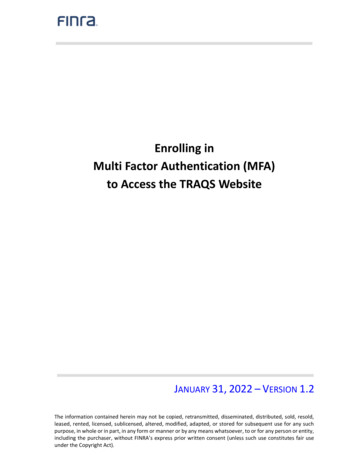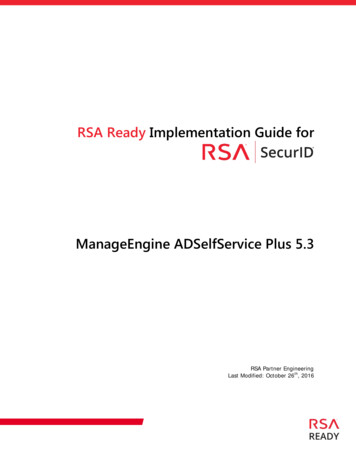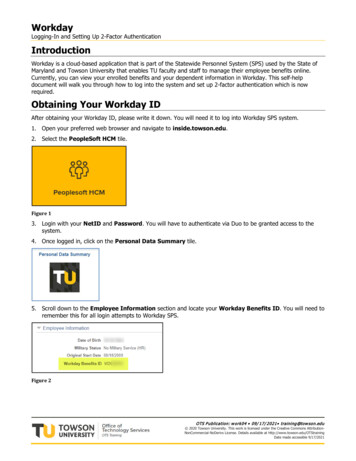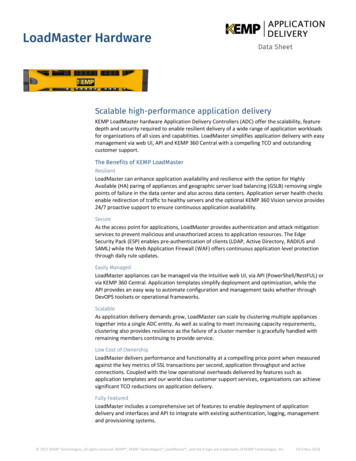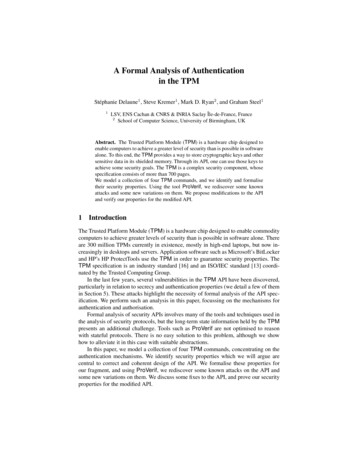
Transcription
A Formal Analysis of Authenticationin the TPMStéphanie Delaune1 , Steve Kremer1 , Mark D. Ryan2 , and Graham Steel11LSV, ENS Cachan & CNRS & INRIA Saclay Île-de-France, France2School of Computer Science, University of Birmingham, UKAbstract. The Trusted Platform Module (TPM) is a hardware chip designed toenable computers to achieve a greater level of security than is possible in softwarealone. To this end, the TPM provides a way to store cryptographic keys and othersensitive data in its shielded memory. Through its API, one can use those keys toachieve some security goals. The TPM is a complex security component, whosespecification consists of more than 700 pages.We model a collection of four TPM commands, and we identify and formalisetheir security properties. Using the tool ProVerif, we rediscover some knownattacks and some new variations on them. We propose modifications to the APIand verify our properties for the modified API.1IntroductionThe Trusted Platform Module (TPM) is a hardware chip designed to enable commoditycomputers to achieve greater levels of security than is possible in software alone. Thereare 300 million TPMs currently in existence, mostly in high-end laptops, but now increasingly in desktops and servers. Application software such as Microsoft’s BitLockerand HP’s HP ProtectTools use the TPM in order to guarantee security properties. TheTPM specification is an industry standard [16] and an ISO/IEC standard [13] coordinated by the Trusted Computing Group.In the last few years, several vulnerabilities in the TPM API have been discovered,particularly in relation to secrecy and authentication properties (we detail a few of themin Section 5). These attacks highlight the necessity of formal analysis of the API specification. We perform such an analysis in this paper, focussing on the mechanisms forauthentication and authorisation.Formal analysis of security APIs involves many of the tools and techniques used inthe analysis of security protocols, but the long-term state information held by the TPMpresents an additional challenge. Tools such as ProVerif are not optimised to reasonwith stateful protocols. There is no easy solution to this problem, although we showhow to alleviate it in this case with suitable abstractions.In this paper, we model a collection of four TPM commands, concentrating on theauthentication mechanisms. We identify security properties which we will argue arecentral to correct and coherent design of the API. We formalise these properties forour fragment, and using ProVerif, we rediscover some known attacks on the API andsome new variations on them. We discuss some fixes to the API, and prove our securityproperties for the modified API.
An overview of the TPM2The TPM stores cryptographic keys and other sensitive data in its shielded memory,and provides ways for platform software to use those keys to achieve security goals.The TPM offers three kinds of functionality:– Secure storage. User processes can store content that is encrypted by keys onlyavailable to the TPM.– Platform authentication. A platform can obtain keys by which it can authenticateitself reliably.– Platform measurement and reporting. A platform can create reports of its integrityand configuration state that can be relied on by a remote verifier.To store data using a TPM, one creates TPM keys and uses them to encrypt the data.TPM keys are arranged in a tree structure, with the storage root key (SRK) at its root.To each TPM key is associated a 160-bit string called authdata, which is analogousto a password that authorises use of the key. A user can use a key loaded in the TPMthrough the interface provided by the device. This interface is actually a collection ofcommands that (for example) allow one to load a new key inside the device, or tocertify a key by another one. All the commands have as an argument an authorisationHMAC that requires the user to provide a proof of knowledge of the relevant authdata.Each command has to be called inside an authorisation session. We first describe thismechanism before we explain some commands in more detail.2.1SessionsThe TPM provides two kinds of authorisation sessions:– Object Independent Authorisation Protocol (OIAP), which creates a session thatcan manipulate any object, but works only for certain commands.– Object Specific Authorisation Protocol (OSAP), which creates a session that manipulates a specific object specified when the session is set up.An authorisation session begins when the command TPM OIAP or TPM OSAP issuccessfully executed.OIAP authorisation session. To set up an OIAP session, the user process sends the command TPM OIAP to the TPM. Then, the user receives back a session handle, togetherwith a nonce. Each command within the session sends the session handle as part of itsarguments, and also a new nonce. Nonces from the user process are called odd nonces,and nonces from the TPM are called even nonces. This system of rotating nonces guarantees freshness of the commands and responses. All authorisation HMACs includethe most recent odd and even nonce. In an OIAP session, the authorisation HMACsrequired to execute a command are keyed on the authdata for the resource (e.g. key)requiring authorisation.2
OSAP authorisation session. For an OSAP session, the user process sends the command TPM OSAP to the TPM, together with the name of the object (e.g. key handle),and an OSAP odd nonce No OSAP . The response includes a session handle, an evennonce for the rolling nonces, and an OSAP even nonce Ne OSAP . Then, the user processand the TPM both compute the OSAP shared secret hmac(auth, hNe OSAP , No OSAP i),i.e. an HMAC of the odd OSAP nonce and the even OSAP nonce, keyed on the object’s authdata. Now commands within such a session may be executed. In an OSAPsession, the authorisation HMACs are keyed on the OSAP shared secret. The purposeof this arrangement is to permit the user process to cache the session key for a possiblyextended session duration, without compromising the security of the authdata on whichit is based.2.2CommandsThe TPM provides a collection of commands that allow one to create some new keysand to manipulate them. These commands are described in [16]. Here, we explain onlya few of them in order to illustrate how the TPM works.To store data using a TPM, one creates a TPM key and uses it to encrypt the data.TPM keys are arranged in a tree structure. The Storage Root Key (SRK) is created bya command called TPM TakeOwnership. At any time afterwards, a user process cancall TPM CreateWrapKey to create a child key of an existing key. Once a key has beencreated, it may be loaded using TPM LoadKey2, and then can be used in an operationrequiring a key (e.g. TPM CertifyKey, TPM UnBind).TPM CreateWrapKey. The command creates the key but does not store it; it simplyreturns it to the user process (protected by an encryption). Assume that the parent keypair (sk , pk(sk )) under which we want to create a new key is already loaded inside thedevice with the authdata auth. Assume also that an OSAP session has been establishedon this key, with ss hmac(auth, hneOSAP , noOSAP i) as the OSAP shared secret andassume the current even rolling nonce associated to this session is ne. The commandcan be informally described as follows:handle(auth, sk ), no, cipher,new SK , new Ne · Ne, pk(SK ), wrp, hmac(ss, hcwk, cipher, ne, noi)hmac(ss, hcwk, wrp, pk(SK ), N e, noi)where:– cipher senc(NewAuth, hash(ss, ne)), and– wrp wrap(pk(sk ), hSK , NewAuth, tpmproofi).The intuitive meaning of such a rule is: if an agent (possibly the attacker) has thedata items on the left, then, by means of the command, he can obtain the data items onthe right. The new keyword indicates that data, e.g. nonces or keys, is freshly generated.The TPM CreateWrapKey command takes arguments that include the handle forthe parent key of the key to be created, an odd rolling nonce that is a priori freshlygenerated by the user, the new encrypted authdata of the key to be created, and theauthorisation HMAC based on the authdata of the parent key. It returns the public part3
pk(SK ) of the new key and an encrypted package; the package contains the private partand the authdata of the new key, as well as the constant tpmproof (a private constantonly known by the TPM). This package is encrypted with the parent key pk(sk ). Anauthentication HMAC is also constructed by the TPM to accompany the response. Thenewly created key is not yet available to the TPM for use.Note that this command introduced a new authdata that is encrypted with the OSAPsecret. Because this arrangement could expose the OSAP shared secret to cryptanalyticattacks if used multiple times, an OSAP session that is used to introduce new authdatais subsequently terminated by the TPM. Commands that want to continue to manipulatethe object have to create a new session.TPM LoadKey2. To use a TPM key, it must be loaded. TPM LoadKey2 takes as argument a wrap created by the command TPM CreateWrapKey, and returns a handle,that is, a pointer to the key stored in the TPM memory. Commands that use the loadedkey refer to it by this handle. Since TPM LoadKey2 involves a decryption by the parent key, it requires the parent key to be loaded and it requires an authorisation HMACbased on the parent key authdata. The root key SRK is permanently loaded and has awell-known handle value, and therefore never needs to be loaded.Once loaded, a key can be used, for example to encrypt or decrypt data, or to signdata. As an illustrative example, we describe the command TPM CertifyKey in moredetail.TPM CertifyKey. This command requires two key handle arguments, representing thecertifying key and the key to be certified, and two corresponding authorisation HMACs.It returns the certificate.Assume that two OIAP sessions are already established with their current evenrolling nonce ne1 and ne2 respectively, and that two keys handle(auth1 , sk1 ) andhandle(auth2 , sk2 ) are already loaded inside the TPM. The TPM CertifyKey command can be informally described as follows:n, no1 , no2 ,new Ne 1 , new Ne 2 ·hmac(auth1 , hcfk, n, ne1 , no1 i)Ne 1 , Ne 2 , certif hmac(auth2 , hcfk, n, ne2 , no2 i)hmac(auth1 , hcfk, n, Ne 1 , no1 , certifi)handle(auth1 , sk1 ), handle(auth2 , sk2 )hmac(auth2 , hcfk, n, Ne 2 , no2 , certifi)where certif cert(sk1 , pk(sk2 )).The user requests to certify the key pk(sk2 ) with the key sk1 . For this, he generatesa nonce n and two odd rolling nonces no1 and no2 that he gives to the TPM togetherwith the two authorisation HMACs. The TPM returns the certificate certif. Two authentication HMACs are also constructed by the TPM to accompany the response. TheTPM also generates two new even rolling nonces to continue the session.3Modelling the TPMIn this section, we first give a short introduction to the tool ProVerif that we used toperform our analysis. We chose ProVerif after first experimenting with the AVISPA4
toolsuite [3], which provides support for mutable global state. However, of the AVISPAbackends that support state, OFMC and CL-AtSe require concrete bounds on the number of command invocations and fresh nonces to be given. It is possible to avoid thisrestriction using SATMC [10], but SATMC performed poorly in our experiments due tothe relatively large message length, a known weakness of SATMC. We therefore optedfor ProVerif using abstractions to model state, as we explain below. We will explainhow the TPM commands as well as its security properties can be formalized in ourframework.3.1The tool ProVerifProVerif takes as input a process written in a syntax close to the one used in the appliedpi calculus [1], a modelling language for security protocols. In particular, it allows processes to send first-order terms built over a signature, names and variables. These termsmodel the messages that are exchanged during a protocol.Example 1. Consider for example the signature Σ {senc, sdec, hmac} which contains three binary function symbols. The signature is equipped with an equational theoryand we interpret equality up to this theory. For instance the theory sdec(senc(x, y), y) x models that decryption and encryption cancel out whenever the same key is used. Wedo not need to consider any equations for modelling an HMAC function.Processes P, Q, R, . . . are constructed as follows. The process 0 is the empty process which does nothing. new a.P restricts the name a in P and can for instance beused to model that a is a fresh random number. in(c, x).P models the input of a term ona channel c, which is then substituted for x in process P . out(c, t) outputs a term t on achannel c. P Q models the parallel composition of processes P and Q. In particular,an input and an output on the same channel in parallel can synchronize and performa communication. The conditional if M N then P else Q behaves as P when Mand N are equal modulo the equational theory and behaves as Q otherwise. !P is thereplication of P , modelling an unbounded number of copies of the process P . Moreover we annotate processes with events ev(t1 , . . . , tn ) which are useful for modellingcorrespondence properties, discussed below. ProVerif can automatically check securityproperties assuming that an arbitrary adversary process is run in parallel.Example 2. Consider the process new k.(!P !Q) whereP ˆ new nP .begin1(nP ).Q ˆ in(c, y);out(c, senc(nP , k)).in(c, x).if y senc(sdec(y, k), k) thenlet (xP , xQ ) sdec(x, k) inlet yP sdec(y, k) in end1(yP ).new nQ .if xP nP then end2(nP , xQ )begin2(yP , nQ ); out(c, senc((yP , nQ ), k))The processes P and Q share a long term symmetric key k which they use to performa handshake protocol. Note that we use some syntactic sugar of the ProVerif syntaxfor readability: final 0 and else 0 are omitted, we use a let construct to introduce localvariables and use a variadic tuple operator (t1 , . . . , tn ) for concatenating terms. For themoment we ignore the begin and end events. The process P first generates a nonce nP5
which is encrypted with the key k. This ciphertext is sent to Q over a channel c. In Q,the test y senc(sdec(y, k), k) is used to check whether decryption succeeds. If itdoes, then the process Q generates a fresh nonce nQ and sends the encryption of bothnonces back to P . Lastly, the process P checks that the received nonce matches thepreviously generated nonce nP .We now discuss correspondence properties, which can be automatically verified byProVerif [4]. A correspondence property ev2(x1 , . . . , xn ) ev1(y1 , . . . , yn ) holds ifon every execution trace each occurrence of ev2(x1 , . . . , xn )σ is preceded by an occurrence of ev1(y1 , . . . , yn )σ where σ is a substitution mapping the xi s and yi s to terms.An injective correspondence property holds if each occurrence of ev2(x1 , . . . , xn )σ ispreceded by a different occurrence of ev1(y1 , . . . , yn )σ. Intuitively, injective correspondence avoids replay attacks.Example 3. Coming back to Example 2, the property end1(x) begin1(x) models that whenever the process Q receives a correctly encrypted message with key k(end1(x) occurs) it must have originated from P (begin1(x) occurs). Moreover, theprocesses P and Q agree on the value of x. This correspondence property indeed holds.However, the stronger injective version does not hold, as the first message of P can bereplayed to Q. The second correspondence property end2(x1 , x2 ) begin1(x1 , x2 )models that whenever the process P finishes a session successfully, it must have interacted with the process Q. This property holds injectively.3.2Modelling commands of the TPMOne of the difficulties in reasoning about security APIs such as that of the TPM is nonmonotonic state. If the TPM is in a certain state s, and then a command is successfullyexecuted, then typically the TPM ends up in a state s0 6 s. Commands that require it tobe in the previous state s will no longer work. Some of the over-approximations madeby tools such as ProVerif do not work well with non-monotonic state. For example,although private channels could be used to represent the state changes, the abstraction ofprivate channels that ProVerif makes prevents it from being able to verify correctness ofthe resulting specification. Moreover, ProVerif does not model a state transition system,but rather a set of derivable facts representing attacker knowledge, together with theassumption that the attacker never forgets any fact.We address these restrictions by introducing the assumption that only one commandis executed in each OIAP or OSAP session. This assumption appears to be quite reasonable. Indeed, the TPM imposes the assumption itself whenever a command introducesnew authdata. Moreover, tools like TPM/J [15] that provide software-level APIs alsoimplement this assumption. Again to avoid non-monotonicity, we do not allow keys tobe deleted from the memory of the TPM; instead, we allow an unbounded number ofkeys to be loaded.An important aspect of the TPM is its key table that allows one to store cryptographic keys and other sensitive data in its shielded memory. Our aim is to allow thekey table to contain dishonest keys, i.e. keys for which the attacker knows the authdata,as well as honest keys. Some of these keys may also share the same authdata. Indeed,6
User CertifyKey ˆin(c, h1 ).in(c, h2 ).in(c, ne1 ).in(c, ne2 ).new N.new No 1 .new No 2 .let (auth1 , pk1 ) (getAuth(h1 ), getPK(h1 )) inlet (auth2 , pk2 ) (getAuth(h2 ), getPK(h2 )) inlet hmac1 hmac(auth1 , (cfk, N, ne1 , No 1 )) inlet hmac2 hmac(auth2 , (cfk, N, ne2 , No 2 )) inUserRequestsC(auth1 , pk1 , auth2 , pk2 ).out(c, (N, No 1 , hmac1 , No 2 , hmac2 )).in(c, (xcert, ne01 , ne02 , hm1 , hm2 )).if hm1 hmac(auth1 , (cfk, N, ne01 , No 1 , xcert)) thenif hm2 hmac(auth2 , (cfk, N, ne02 , No 2 , xcert)) thenUserConsidersC(auth1 , pk1 , auth2 , pk2 , xcert).Fig. 1. Process User CertifyKeyit would be incorrect to suppose that all keys have distinct authdata, as the authdatamay be derived from user chosen passwords. Our first idea was to use a binary functionsymbol handle(auth, sk ) to model a handle to the secret key sk with authdata auth. Weuse private functions, i.e. functions which may not be applied by the attacker, to allowthe TPM process to extract the authdata and the secret key from a handle. This modelsa lookup in the key table where each handle can indeed be associated to its authdataand private key. Unfortunately, with this encoding ProVerif does not succeed in proving some expected properties. The tool outputs a false attack based on the hypothesisthat the attacker knows two handles handle(auth 1 , sk ) and handle(auth 2 , sk ) which arebuilt over two distinct authdata but the same secret key (which is impossible). We therefore use a slightly more involved encoding where the handle depends on the authdataand a seed; the secret key is now obtained by applying a binary private function symbol(denoted hsk hereafter) to both the authdata and the seed. Hence, handle(auth 1 , s) andhandle(auth 2 , s) will now point to two different private keys, namely hsk(auth 1 , s)and hsk(auth 2 , s). This modelling avoids false attacks.In our modelling we have two processes for each command: a user process anda TPM process. The user process (e.g. User CertifyKey) models an honest user whomakes a call to the TPM while the TPM process (e.g. TPM CertifyKey) models theTPM itself. The user process first takes parameters, such as the key handles used forthe given command, and can be invoked by the adversary. This allows the adversary toschedule honest user actions in an arbitrary way without knowing himself the authdatacorresponding to the keys used in these commands.Our model assumes that the attacker can intercept, inject and modify commands sentby applications to the TPM, and the responses sent by the TPM. While this might not bethe case in all situations, it seems to be what the TPM designers had in mind; otherwise,neither the authentication HMACs keyed on existing authdata, nor the encryption ofnew authdata described in section 2.2 would be necessary.7
TPM CertifyKey ˆnew Ne 1 .new Ne 2 .out(c, Ne 1 ).out(c, Ne 2 ).in(c, n).in(c, (h1 , no1 , hm1 )).in(c, (h2 , no2 , hm2 )).let (auth1 , sk1 , pk1 ) (getAuth(h1 ), getSK(h1 ), getPK(h1 )) inlet (auth2 , sk2 , pk2 ) (getAuth(h2 ), getSK(h2 ), getPK(h2 )) inif hm1 hmac(auth1 , (cfk, n, Ne 1 , no1 )) thenif hm2 hmac(auth2 , (cfk, n, Ne 2 , no2 )) thenlet certif cert(sk1 , pk2 )inout(c, certif ).TpmC(auth1 , pk1 , auth2 , pk2 , certif ).new Ne 01 .new Ne 02 .let hmac1 hmac(auth1 , (cfk, n, Ne 01 , no1 , certif )) inlet hmac2 hmac(auth2 , (cfk, n, Ne 02 , no2 , certif )) inout(c, (Ne 01 , Ne 02 , hmac1 , hmac2 )).Fig. 2. Process TPM CertifyKeyWe now illustrate our modelling on the TPM CertifyKey command in an OIAPsession. The process User CertifyKey is detailed in Figure 1. This process starts byinputing two handles h1 , h2 which are provided by the attacker. In this way the attacker can schedule with which keys this command is executed. The user also inputstwo even nonces which are supposed to come from the TPM. Then the user constructsthe two authorisation HMACs for the corresponding nonces using the authdata andpublic keys extracted out of the handles and outputs these HMACs together with thenonces. The event UserRequestsC is used to declare that the user requested the command with the given parameters. When receiving the reply the user checks the receivedHMACs. If all checks go through the user triggers the event UserConsidersC. The process TPM CertifyKey is detailed in Figure 2 and does the complementary actions to theuser process. We may note that when the attacker knows the authdata corresponding toa handle he can directly interact with this process without the user process.3.3Security Properties of the TPMThe TPM specification does not detail explicitly which security properties are intendedto be guaranteed, although it provides some hints. The specification [16, Part I, p.60]states that: “The design criterion of the protocols is to allow for ownership authentication, command and parameter authentication and prevent replay and man in the middleattacks.” We will formalise these security properties as correspondence properties:1. If the TPM has executed a certain command, then a user in possession of the relevant authdata has previously requested the command.2. If a user considers that the TPM has executed a certain command, then either theTPM really has executed the command, or an attacker is in possession of the relevant authdata.The first property expresses authentication of user commands, and is achieved bythe authorisation HMACs that accompany the commands. The second one expresses8
authentication of the TPM, and is achieved by the HMACs provided by the TPM withits answer. We argue that the TPM certainly aims at achieving these properties, as otherwise there would be no need for the HMAC mechanism. Going back to the exampleof the TPM CertifyKey command (Figures 1 and 2) the above mentioned propertiescan be expressed by the injective correspondence properties:1. TpmC(x1 , x2 , x3 , x4 , x5 ) UserRequestsC(x1 , x2 , x3 , x4 ), and2. UserConsidersC(x1 , x2 , x3 , x4 , x5 ) TpmC(x1 , x2 , x3 , x4 , x5 ).These properties, however, cannot hold if we provide the attacker with a dishonestkey, i.e. a handle for which he knows the corresponding authdata. Indeed, the attackercan simply execute the command without the user process. Hence, if we provide the attacker with a handle handle(auth i , seed i ) and the authdata auth i , we weaken the property to avoid the trivial failure of the property. We cannot expect the property to holdwhen x1 and x3 are both instantiated with auth i . However, as soon as we give the attacker the possibility to create new keys (using the TPM CreateWrapKey command),the attacker can create new keys and again make the property trivially fail. Hence, whenwe consider a scenario in which new keys can be loaded, we consider the following formalization:1. TpmC(x1 , x2 , x3 , x4 , x5 ) UserRequestsC(x1 , x2 , x3 , x4 , x5 ) (I(x1 ) I(x3 ))2. UserConsidersC(x1 , x2 , x3 , x4 , x5 ) TpmC(x1 , x2 , x3 , x4 , x5 ) (I(x1 ) I(x3 )).where I is the attacker knowledge predicate. Hence, we allow the property to fail if thecommands are executed with keys for which the attacker knows the authdata.4Analysing the TPM with ProVerifAll the files for our experiments described below are available on line at:http://www.lsv.ens-cachan.fr/ delaune/TPM/In the figures describing attacks, for the sake of clarity, we sometimes omit some partsof the messages, especially session handles that we do not consider in our model andkey handles when they are clear from the other messages.Our methodology was to first study some core key management commands in isolation to analyse the weakness of each command. This leads us to propose some fixes forthese commands. Then, we carried out an experiment where we consider the commandsTPM CertifyKey, TPM CreateWrapKey, TPM LoadKey2, and TPM UnBind together. We consider the fixed version of each of these commands and we show in Experiment 10 that the security properties are satisfied for a scenario that allows:– an attacker to load his own keys inside the TPM, and– an honest user to use the same authdata for different keys.In our first six experiments, we model the command TPM CertifyKey in isolation. Then, in Experiments 7-9, we model the command TPM CreateWrapKey only.Lastly, in Experiment 10, we consider a model where the commands TPM CertifyKey,TPM CreateWrapKey, TPM LoadKey2, and TPM UnBind are taken into account.In all experiments, the security properties under test are the correspondence propertiesexplained above.9
Experiment 1. In our first two experiments, we consider a configuration with two keysloaded inside the TPM. The attacker knows the two handles handle(auth 1 , sk 1 ) andhandle(auth 2 , sk 2 ). From the handle handle(auth 1 , sk 1 ), the attacker can obtain thecorresponding public key pk(sk 1 ). However, he can obtain neither the private key sk 1 ,nor the authdata auth 1 required to manipulate the key through the device. For the moment, we assume that the attacker does not have his own key loaded onto the device.ProVerif immediately discovers an attack, described in Figure 3, that comes fromthe fact that the command involved two keys. The attacker can easily swap the roleof these two keys: he swaps the two HMACs, the two key handles, and the rollingnonces provided in input of the command. Hence, the TPM will output the certificatecert(sk 2 , pk(sk 1 )) whereas the user asked for obtaining the certificate cert(sk 1 , pk(sk 2 )).By performing also the swap on the answer provided by the TPM, the attacker canprovide two valid HMACs to the user who will accept the wrong certificate. Hence, thesecond correspondence property is not satisfied. Note that if the user chooses to verifythe certificate he received with the checkcert algorithm, then this attack is not validanymore and ProVerif is able to verify that this second correspondence property holds.Initial knowledge of Charlie: handle(auth 1 , sk 1 ), handle(auth 2 , sk 2 ).Trace: Charlie swaps the two authorisation HMACs, and swaps the two response HMACs.USER TPM : request to open two OIAP sessionsTPM USER : ne1 , ne2USER requests key certification to obtain cert(sk 1 , pk(sk 2 ))USER Charlie : n, no1 , no2 ,hmac(auth 1 , hcfk, n, ne1 , no1 i),hmac(auth 2 , hcfk, n, ne2 , no2 i)Charlie TPM : n, no2 , no1 ,hmac(auth 2 , hcfk, n, ne2 , no2 i),hmac(auth 1 , hcfk, n, ne1 , no1 i) Charlie : ne01 , ne02 , cert(sk 2 , pk(sk 1 )),hmac(auth 2 , hcfk, n, ne01 , no2 i), hmac(auth 1 , hcfk, n, ne02 , no1 i)Charlie USER : ne02 , ne01 , cert(sk 2 , pk(sk 1 )),hmac(auth 1 , hcfk, n, ne02 , no1 i), hmac(auth 2 , hcfk, n, ne01 , no2 i)TPMUSER checks the HMACs and accepts the certificate cert(sk 2 , pk(sk 1 )).Fig. 3. Attack trace for Experiment 1.Experiment 2. We patch the command TPM CertifyKey by considering two differenttags for the two different HMACs. More precisely, we replace the constant cfk withcfk1 (resp. cfk2 ) in the first (resp. second) HMAC provided by the user and also theone provided by the TPM. The attacks reported in our first experiment are prevented.ProVerif is now able to verify the two correspondence properties.Experiment 3. We add in the initial configuration another key for Alice and we assume that this new key sk 02 has the same authdata as a previous key of Alice al10
ready loaded onto the TPM. Hence, in our model, we have that handle(auth 1 , sk 1 ),handle(auth 2 , sk 2 ), and handle(auth 2 , sk 02 ) are terms known by the attacker Charlie.ProVerif immediately discovers another attack, described in Figure 4. The attackercan exchange the key handle handle(auth 2 , sk 2 ) provided by the honest user in entry ofthe command with another handle having the same authdata, i.e. handle(auth 2 , sk 02 ).The TPM will answer by sending the certificate cert(sk 1 , pk(sk 02 )) together with thetwo HMACs. After verifying the HMACs, the user will accept this certificate whichis not the right one. Indeed, the user was expecting to receive cert(sk 1 , pk(sk 2 )). Thetrace described in Figure 4 shows that none of the two correspondence properties holds.Initial knowledge of Charlie: handle(auth 1 , sk 1 ), handle(auth 2 , sk 2 ), handle(auth 2 , sk 02 ).Trace: Charlie swaps a key handle for another one that has the same authdata.USER TPM : request to open two OIAP sessionsTPM USER : ne1 , ne2USER requests key certification to obtain cert(sk 1 , pk(sk 2 ))USER Charlie : n, no1 , handle(auth 1 , sk 1 ), hmac(auth 1 , hcfk, n, ne1 , no1 i),no2 , handle(auth 2 , sk 2 ), hmac(auth 2 , hcfk, n, ne2 , no2 i)Charlie TPM : n, no1 , handle(auth 1 , sk 1 ), hmac(auth 1 , hcfk, n, ne1 , no1 i),no2 , handle(auth 2 , sk 02 )
The TPM provides a collection of commands that allow one to create some new keys and to manipulate them. These commands are described in [16]. Here, we explain only a few of them in order to illustrate how the TPM works. To store data using a TPM, one creates a TPM key and uses it to encrypt the data. TPM keys are arranged in a tree structure.

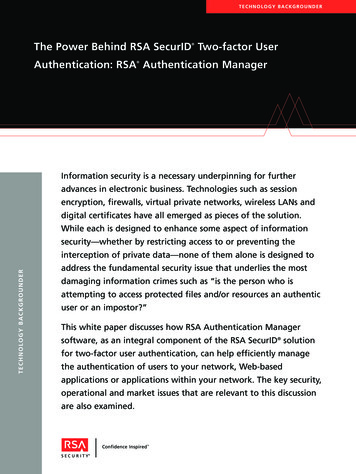
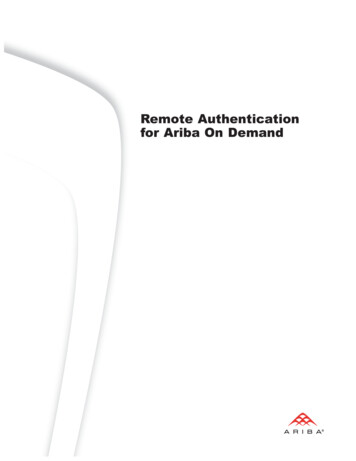
![[MS-OFBA]: Office Forms Based Authentication Protocol](/img/3/ms-ofba.jpg)


